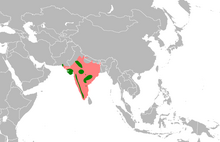ചാട്ടക്കോഴി
ചാട്ടക്കോഴിയെ ഇംഗ്ലീഷിൽ "Lesser Floricans" എന്നു പറയുന്നു. ഇന്ത്യന് ഉപഭൂഖണ്ഡത്തിലെ തദ്ദേശ ഇനമാണ്. ഇതിന് വടക്കേ ഇന്ത്യയിൽ "Likh" എന്നും പേരുണ്ട്. [2][3][4] ഇത് ബസ്റ്റാർഡ് കുടുംബത്തിലെ ഏറ്റവും ചെറിയതും സിഫിയോടൈഡ്സ് ജനുസ്സിലെ ഏക അംഗവുമാണ്. പുഴുക്കൾ, പല്ലികൾ, തവള, പുൽച്ചാടികൾ അടക്കമുള്ള ചെറുജീവികളെ തിന്നു ജീവിക്കുന്നു. ചെടികളും വിത്തുകളും ഭക്ഷണമാണ്..[5] [5]വേട്ടയാടലും ആവാസവ്യവസ്ഥയുടെ തകർച്ചയും ഇതിന് ഭീഷണിയാണ്. അതിനാൽ ഇവ വംശനാശഭീഷണി നേരിടുന്നു.
| ചാട്ടക്കോഴി | |
|---|---|

| |
| ശാസ്ത്രീയ വർഗ്ഗീകരണം | |
| കിങ്ഡം: | |
| Phylum: | |
| Class: | |
| Order: | |
| Family: | |
| Genus: | Sypheotides Lesson, 1839
|
| Species: | S. indicus
|
| Binomial name | |
| Sypheotides indicus (Miller, 1782)
| |

| |
| Spot distribution map (includes historic records) | |

| |
| Overall distribution (reddish) and breeding areas (green) | |
| Synonyms | |
|
Sypheotis aurita | |
രൂപവിവരണം
തിരുത്തുകആൺ പക്ഷിയുടെ മഴക്കാലത്തെ, പ്രജനനകാലത്തെ അഭ്യാസ പ്രകടങ്ങള് പേരുകേട്ടതാണ്. പ്രജനന കലത്ത് പൂവന് തലയും കഴുത്തും അടിവശവും കറുപ്പാണ്. കൂടാതെ തലയുടെ ഇരു വശത്തുനിന്നും തൂവലുകള് കഴുത്തുവരെ നീണ്ടു കിടക്കുകയും ചെയ്യും. ചിറകുമൂടികള് വെളുപ്പാണ്.
പ്രജനന കാലമല്ലാത്തപ്പോള് പൂവനും പിടയും കറുത്ത വരകളോട് കൂടിയ ചാരനിറമാണ്. പിട പൂവനേക്കാള് വലുതാണ്. കാലും കണ്ണുകളും മഞ്ഞയാണ്. [6][7]
ഇവയെ ഒറ്റ്യ്ക്കോ ജോടികളായോ കാണുന്നു. തിങ്ങി നിറഞ്ഞ പുല്ലുള്ള സ്ഥലങ്ങളിലൊ കൃഷിയിടങ്ങളിലൊ കാണുന്നു.
പ്രജനനം
തിരുത്തുകവടക്കേ ഇന്ത്യയിൽ പ്രജനനം സെപ്തംബർ മുതൽ ഒക്ടോബർ വരേയും, തെക്കേ ഇന്ത്യയിൽ അത് ഏപ്രിൽ മുതൽ മേയ് വരെയുമാണ്. [8] കൂട് അധികം താഴ്ച്ചയില്ലാതെ തറയിലാണ് ഉണ്ടാക്കുന്നത്. 3-4 മുട്ടകളാണ് ഇടുന്നത്.[6] അടയിരിക്കുന്നത് മുഴുവനും പിടയാണ്. 21 ദിവസം കൊണ്ട് മുട്ടവിരിയും[9].
അവലംബം
തിരുത്തുക- ↑ "Sypheotides indicus". IUCN Red List of Threatened Species. Version 2012.1. International Union for Conservation of Nature. 2012. Retrieved 16 July 2012.
{{cite web}}: Cite has empty unknown parameter:|last-author-amp=(help); Invalid|ref=harv(help); Unknown parameter|authors=ignored (help) - ↑ Finn, Frank (1915). Indian Sporting Birds. Francis Edwards, London. pp. 136–138.
- ↑ Russell, CEM (1900). Bullet and Shot in Indian forest, plain and hill. W Thacker and Co, London. pp. 383–384.
- ↑ Jerdon, TC (1864). The birds of India. Vol. 3. George Wyman and Co, Calcutta. pp. 619–625.
- ↑ 5.0 5.1 http://awsassets.wwfindia.org/downloads/panda__special_issue.pdf. Retrieved 9 June 2013.
{{cite web}}: Cite has empty unknown parameter:|authors=(help); Missing or empty|title=(help) - ↑ 6.0 6.1 Baker, ECS (1929). The Fauna of British India, Including Ceylon and Burma. Birds. Volume 6 (2 ed.). Taylor and Francis, London. pp. 68–71.
- ↑ Rasmussen PC & JC Anderton (2005). Birds of South Asia: The Ripley Guide. Volume 2. Smithsonian Institution & Lynx Edicions. pp. 149–150.
- ↑ Ali, S & S D Ripley (1980). Handbook of the birds of India and Pakistan. Vol. 2 (2 ed.). Oxford University Press. pp. 196–198.
- ↑ ഉദ്ധരിച്ചതിൽ പിഴവ്: അസാധുവായ
<ref>ടാഗ്;nlbwഎന്ന പേരിലെ അവലംബങ്ങൾക്ക് എഴുത്തൊന്നും നൽകിയിട്ടില്ല.
